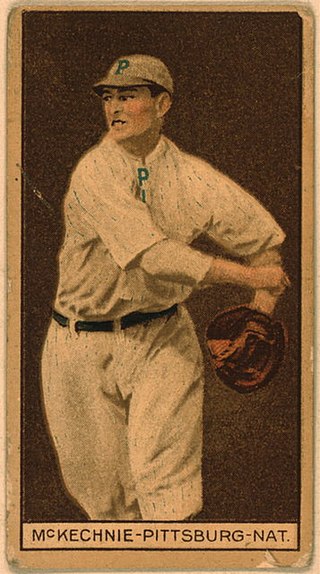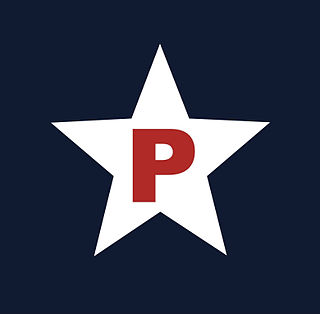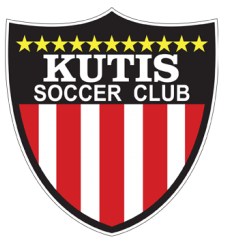Year-by-year
| Year | League | Reg. Season | Challenge Cup |
|---|---|---|---|
| 1946 | NASFL | 3rd | ? |
| 1947 | 1st |
Pittsburgh Indians were a mid-twentieth-century American soccer club based in Pittsburgh, Pennsylvania. It began as Pittsburgh Stasser before becoming the Indians in 1947.
In 1946, several successful Midwest U.S. teams organized the first professional, regional soccer league outside of the east coast. The North American Soccer Football League played an eight-game season in 1946, then the first half of the 1947 season before collapsing in the fall of 1947. Peter Strasser entered a team, known as Pittsburgh Stasser in the league. [1] Pittsburgh was renamed the Indians in 1947 and led the standings for the first half of the season. As the league collapsed soon after, they are considered the de facto 1947 champions. [2]
| Year | League | Reg. Season | Challenge Cup |
|---|---|---|---|
| 1946 | NASFL | 3rd | ? |
| 1947 | 1st |

The American Hockey League (AHL) is a professional ice hockey league based in the United States and Canada that serves as the primary developmental league for the National Hockey League (NHL). Since the 2010–11 season, every team in the league has an affiliation agreement with one NHL team. When NHL teams do not have an AHL affiliate, players are assigned to AHL teams affiliated with other NHL teams. Twenty-six AHL teams are located in the United States and the remaining six are in Canada. The league offices are located in Springfield, Massachusetts, and its current president is Scott Howson.
The second Negro National League was one of the several Negro leagues that were established during the period in the United States when organized baseball was segregated. The league was founded in 1933 by businessman Gus Greenlee of Pittsburgh.

The Kansas City Monarchs were the longest-running franchise in the history of baseball's Negro leagues. Operating in Kansas City, Missouri, and owned by J. L. Wilkinson, they were charter members of the Negro National League from 1920 to 1930. J. L. Wilkinson was the first Caucasian owner at the time of the establishment of the team. In 1930, the Monarchs became the first professional baseball team to use a portable lighting system which was transported from game to game in trucks to play games at night, five years before any major league team did. The Monarchs won ten league championships before integration, and triumphed in the first Negro League World Series in 1924. The Monarchs had only one season in which they did not have a winning record. The team produced more major league players than any other Negro league franchise. It was disbanded in 1965.

William Boyd McKechnie was an American professional baseball player, manager and coach. He played in Major League Baseball as a third baseman during the dead-ball era. McKechnie was the first manager to win World Series titles with two teams, and remains one of only two managers to win pennants with three teams, also capturing the National League title in 1928 with the St. Louis Cardinals. His 1,892 career victories ranked fourth in major league history when he ended his managing career in 1946, and trailed only John McGraw's NL total of 2,669 in league history. He was nicknamed "Deacon" because he sang in his church choir and generally lived a quiet life.

The United Soccer League was a professional soccer league in the United States in the mid-1980s.

The Cleveland Buckeyes were a Negro league baseball team that played from 1942 to 1950 in the Negro American League. The Buckeyes played in two Negro World Series, defeating the Washington Homestead Grays in 1945, and losing to the New York Cubans in 1947. They were based in Cincinnati for their first season and Louisville for their second-to-last season.

William Adam Meyer was an American baseball player and manager. He holds the dubious distinction of having played with, then managed, two of the worst teams in the history of Major League Baseball.

The Philadelphia Stars were a Negro league baseball team from Philadelphia. The Stars were founded in 1933 when Ed Bolden returned to professional black baseball after being idle since early 1930. The Stars were an independent ball club in 1933, a member of the Negro National League from 1934 until the League's collapse following the 1948 season, and affiliated with the Negro American League from 1949 to 1952.

Philip Samuel Masi was an American professional baseball player. From 1939 though 1952, he played in Major League Baseball as a catcher for the Boston Braves (1939–1949), Pittsburgh Pirates (1949) and Chicago White Sox (1950–1952). Although he was known for being one of the best defensive catchers of his era, Masi was notable for his involvement in a controversial play that occurred during the 1948 World Series between the Boston Braves and the Cleveland Indians.
The North American Soccer Football League, also known as the North American Football League, was a soccer league that operated for two seasons, 1946 and 1947.

St. Louis Kutis Soccer Club, better known as St. Louis Kutis, is an amateur American soccer club in St. Louis, Missouri. Founded in 1947 as the "St. Louis Raiders", the club was known as "Paul Schulte" during the 1948–49 season, "McMahon's" during the 1949–50 season and "Zenthoefer's" in the 1950–51 season. In 1953, the team was renamed "St. Louis Kutis". The club gained its greatest prominence in the 1950s when it dominated both St. Louis and national soccer competitions. In 1958, the United States Soccer Federation used Kutis, with a few guest players, as the U.S. national team in two World Cup qualifying matches.
Donald Paul Black was an American right-handed pitcher in Major League Baseball who played for six seasons in the American League with the Philadelphia Athletics and Cleveland Indians. In 154 career games, Black pitched 797 innings and posted a win–loss record of 34–55, with 37 complete games, four shutouts, and a 4.35 earned run average (ERA).
Nicholas DiOrio was a member of the U.S. national team at the 1950 FIFA World Cup. He is a member of the National Soccer Hall of Fame.
The 1946 Pittsburgh Pirates season was the 65th in the history of the Major League Baseball franchise and its jubilee of diamonds in the National League. The Pirates finished seventh in the league standings with a record of 63–91, and attracted 749,962 fans to Forbes Field, also seventh in the eight-team Senior Circuit and 13th among the 16 MLB clubs.
Ponta Delgada Soccer Club, also referred to as Fall River Ponta Delgada, was a United States soccer club, based in Fall River, Massachusetts. The club was formed by members of the city’s Portuguese community and shared its name with Ponta Delgada, the largest city of the Azores, an autonomous region of Portugal. During the 1930s, 1940s and 1950s they were one of the most successful amateur teams in the United States, winning the National Amateur Cup six times. In 1947 they won the first-ever National Challenge Cup / National Amateur Cup double. The same year their entire squad was selected en masse to represent the United States at the inaugural North American soccer championship. Between 1951 and 1953 they also played in the American Soccer League. They played some home games at Mark's Stadium in North Tiverton, Rhode Island, previously the home of Fall River F.C.. Like the 'Marksmen', they did this to avoid the Massachusetts Blue Laws that prevented them from playing Sunday games.
Paul “Doots” Danilo was born in South Fayette Township, Pennsylvania and was a U.S. soccer outside right who played most of his career with amateur teams in western Pennsylvania. He scored the winning goal in the 1940 National Amateur Cup and later served as a coach and administrator on both the local and national levels. Danilo is a member of the National Soccer Hall of Fame.
The "Dixie League" was a professional american football minor league founded in 1936 originally as the "South Atlantic Football Association", with six charter member teams in the Middle Atlantic states of Maryland, Virginia, and Washington, D.C. Like the American Association (nicknamed the 'A.A.', which was another minor league in pro football that formed in 1936,, its popularity rivaled that of another earlier established "major league" grouping, the National Football League of 1922. Unlike most professional football minor leagues, the "Dixie League" had a relative stability in membership during the "Great Depression" in the years prior to World War II, maintaining a five or six-team lineup membership of franchises.
The 1947 North American Soccer Football League season featured a 30-match schedule from 6 April to 30 August, with all six teams scheduled to play 10 matches each. The champion Detroit Wolverines had dropped out of the league, while both the Detroit Pioneers and St. Louis Raiders were added to the league. The Pittsburgh Indians and Toronto Greenbacks finished tied for first place with 14 points each, thus requiring a two-match playoff to decide a champion. The two matches were played in October, with Pittsburgh winning both matches to claim the championship.
The American Soccer League, established in 1921, was the first of four different professional soccer sports leagues in the United States to use the ASL name. It was formed by the merger of teams from the National Association Football League and the Southern New England Soccer League. For several years the ASL's popularity rivaled the popularity of the National Football League. Disputes with the United States Football Association and FIFA, as well as the onset of the Great Depression, led to the league's collapse in spring 1933.